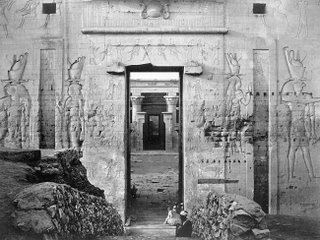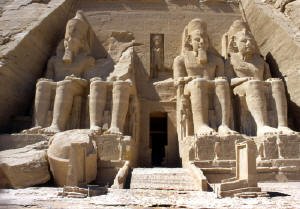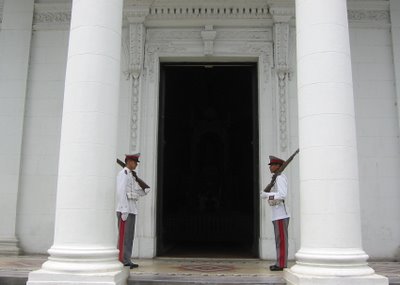
I have to admit, Egypt has always been a destination I've dreamed of, like since I was a kid even. I mean, in our culture-- replete with Bible stories, mummy movies, Napoleon, Israel, hi-tech aliens building pyramids, Cleopatra-- how could it not be? And if you've been following this blog at all, you've probably figured out that Roland and I have always been looking for cool and challenging places to go experience. Egypt sounded really exotic to us both and we finally made it over about a decade ago.
We planned to spend about a week in Cairo and a couple weeks roaming the country (including a Nile cruise to Aswan). Although it didn't seem so at the moment, some real misfortune for everyone else turned into a break for me and Roland. Just as we were leaving L.A. in November a bunch of religionist fanatics slaughtered a busload of tourists from Switzerland or Austria and Japan. It was really a spectacular horror show with scimitar-wielding terrorists chasing unarmed tourists through the ruins and mercilessly slashing them to death. It was a bloody slaughter; 5 dozen were murdered. Egypt, one of the world's biggest tourist destinations, immediately emptied of tourists. And they stopped coming (at for a couple weeks). I feel terrible for the Austrians and Japanese, of course; I mean what a way to go! But... well, Roland and I pretty much had Egypt to ourselves. I mean it was just us and the Egyptians, who, except for the scimitar-wielders, are an extremely generous, friendly and gracious people.
Example of how this worked: the cruise. Normally these big boats are packed-- hundreds of people (including brats) running around making noise and slowing everything down. And the cabins are tiny little cells. I mean really, really tiny. The giant ship had a full crew (which included an Egyptologist) plus me, Roland and two sprightly old Brits returning to London from a lifetime of foreign service in Oman and seeing Egypt on the way home. That's right; instead of a couple hundred tourists we were four. The first result was that instead of Roland and I having to share one of these tiny cells, we each got our own tiny cell. Still horrible but an improvement. Later the Egyptologist explained to us that no tour group in his experience on the Nile had seen as many things as we had. That's because normally the tour goes as slow as the oldest and most crippled turtle-like member. The 4 of us were all really into seeing everything-- and we did.
We flew to Cairo on TWA direct from L.A. They're out of business now. Some guy from the Warner Bros affiliate picked us up at the airport and whisked us through an otherwise annoying customs rigmarole and hassel-hell. We checked into Le Meridien on Roda Island right in the center of town connected to the Corniche by its own bridge, and got a great room with a balcony overlooking the Nile. Good hotel with the best views of Cairo in the city and not expensive at all (although it probably is now). On the way back we decided to stay in the Sheraton in Dokki, a little bit away from the hectic part of town but still convenient. It was pretty inexpensive too, although I have a feeling that all the prices were down because of the recent brutal murders of all the tourists.
Food in Egypt is definitely nothing to write home about. It's amazing that such an ancient culture doesn't have a unique cuisine, like China or Morocco or Turkey. But they don't. It's kind of garden-variety Middle Eastern. The restaurants were non-descript from a culinary perspective, although the food was ok. On the cruise there was always the very boring, semi-bland choice of "chicken or fish."
If you've looked through my blog, you're no doubt aware about how I delight in the cuisines of the countries I visit. Scratch Egypt off that list. There was not one memorable restaurant in almost a month! Even the lavish ones the Warner Bros affiliate people brought us to served food that was just slightly better than mediocre. This was definitely not a food trip. It was a tombs trip.
In Cairo the biggest deal is, of course, the Pyramids. And were we in luck on that score! You know the guy always on CNN whenever they do a story on mummies or anything old in Egypt-- Dr. Zahi Hawass? Well, one of the musicians, Andy Paley, in a band on Sire Records, where I used to work, was friends with some well-known American Egyptologist, a Rockefeller no less, and through this guy we had an introduction to Dr. Hawass, then Governor of the Pyramids (now Secretary General of the Supreme Council of Antiquities). This turned out to be a golden key to the most amazing visit to the Pyramids imaginable.
Dr. Hawass treated us to a tour usually reserved for heads of state. He literally closed down the Great Pyramid and made everyone else wait while we had it to ourselves! It's pretty awesome. Most things don't live up to expectations; that one did. He said we could sleep in it if we wanted to. We didn't at the time but now I'm sorry we didn't take him up on it. We didn't climb any pyramids the way Bush just did in Chichen Itzen in Mexico last week, looking like a pansy. We didn't because a U.S. marine climbed up and fell off and died; so it's forbidden now. Afterwards he showed us a small, locked up pyramid that no one is allowed in except Charles De Gaulle and other people they wanted to impress. They don't want general traffic in there because of breathing. Next door they had a little museum with an ancient ship with a bunch of mummified pharaoh's servants on it. The Sphinx, on the other hand, was covered in scaffolding and seemed to be crumbling into the sand. Roland claims they were injecting silicon into it.
The other stuff in Cairo we went were the Egyptian Museum, which was like an over-stuffed warehouse but still amazingly interesting; El Azhar Mosque (the spiritual center of Old Cairo where, unlike the Moroccan mosques, all are welcome); the 12th Century Citadel and the Muhammed Ali Mosque (an incredibly magnificent Turkish-style mosque also known as the Alabaster Mosque and unrelated to boxers); and the City of the Dead, basically a gigantic cemetery with hundreds of thousands of people living in it.
After a pleasant enough week in Cairo we took an Egypt Air flight to Luxor to meet our Nile ship. Luxor is really spectacular (although it took some effort to put all the screaming, terrorized Austrians and Japanese being hacked to bits by the terrorists out of our minds). The temples, big and small, and burial areas in the outskirts-- The Valley of Kings and The Valley of Queens-- were mind-boggling and themselves worth a trip to Egypt. We stayed on the ship and they took over the routine, starting with the Temple of Karnak-- the heart of the Amon cult and one of the most spectacular sites either of us has ever seen... anywhere. After seeing it, the also incredible-- albeit much smaller and less grand-- Temple of Luxor wasn't nearly as breathtaking and memorable. We wound up going back to the Temple of Karnak for a cool touristy sound and light show the next night. The boat stayed tied up on the dock for a few days-- a floating hotel/restaurant for us, while we explored the Luxor region. It was really amazing. We were supposed to sail north to Dendara to see the Temple of Hathor, the goddess of love, but the Nile was too low so they kept us in Luxor longer-- which was fine with us-- and gave us a gift certificate for a night at the Hilton Hotel in Taba on the Sinai.
It's 140 miles from Luxor to Aswan and this was the heart of our trip. We (me and Roland and the two old Brits) stopped everywhere and did everything. First stop was Esna, a tiny ancient agricultural town-- we were in rural ancient Egypt now-- with an awesome little temple dedicated to Khnum, the ram-headed god. On the other side of the river and 30 miles away is Edfu. By this time we felt really comfortable on our ship and we had taken over the sound system and were playing Velvet Underground tapes as we watched ancient Egypt float by. The Temple of Edfu, the holiest site of Horus, the falcon god, is the most intact temple we saw on our whole trip. In some ways this was the one, the one where it was easiest to fantasize that I was an Egyptian living a thousand years before Christ. I wasn't in the real world any longer.

Next came Kom Ombo, the site of the temple to Sobek, the crocodile god. Roland loved it. I felt I had seen enough temples by then and I hate and fear crocodiles anyway. I was also getting bored with the crappy food on the boat and I was happy when the boat Egyptologist told us if we wanted to we could go for a camel excursion into the Libyan Desert to visit an old Coptic monastery. We all jumped at the chance and we had a truly remarkable day, although Roland picked up some accursed Arabic phrase that made my nasty camel run off whenever he shouted it.
Our last stop was Aswan, best known for the Aswan Dam, of course, but there are some pretty cool things to see there too. I think the last thing we did as part of our organized cruise was to take a falucca to Elephantine Island and Kitchener's Island to visit the gardens. It was very beautiful and peaceful and helped feed my fantasy about living 3,000 years ago. We checked into the Pullman Cataract Hotel, famous as the site of the film Death on the Nile and very beautiful-- Moorish in style. It's a luxury hotel but it was inexpensive and not really all that luxurious. Like everywhere in Egypt, the food was mediocre.
On a lark we decided to go see Abu Simbel, way down near Sudan, the gateway to Africa. We flew there from Aswan on ZAS. Most people fly in for a few hours and fly out with the same group. We were the only ones who stayed. The town gets lively when the planeful of tourists arrives and then gets real sleepy when they fly back in the evening. We loved being the only ones in this very primitive African town. We found a basic hostel to stay in. There were no real hotels. I don't recall any real restaurants either and we traded a farmer a pen for some tomatoes. The Temple of Rameses was as spectacular and awe-inspiring as the photos lead you to believe it is.
We wound up flying back to Cairo and I let Roland talk me into taking a night bus through the Sinai to Taba (to use our gift certificate and cross over and visit Eliat). We went to visit Jerusalem too-- and spent Christmas Eve in Bethelhem where tradition says Jesus was born, but that part of the trip is for another time.
UPDATE: Egyptian Roads
They should be avoided when possible. Christmas week, 2010 and a bus crashed into a truck, killing 8 American tourists, injuring 21 others, going from Aswan to Abu Simbel. Better to fly.
The crash took place early Sunday as the tourists were traveling from Aswan to Abu Simbel, the site of an ancient Egyptian temple.
Road accidents are common in Egypt because of bad roads and poor enforcement of traffic rules. An estimated 8,000 people die in car accidents annually in the country.




























